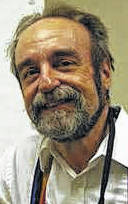
On Saturday, Oct. 14, the moon will pass between Earth and the sun, and central Ohioans will witness a partial solar eclipse.
Please attend to the following safety provisos.
You should never, and I mean never, look at the sun without proper safety equipment. Don’t look at the sun without ISO-certified eclipse glasses or an approved hand-held solar filter, usually made from the same material as the glasses.
Don’t look at the sun in a telescope unless that telescope has an approved FRONT-END solar filter.
Always inspect your solar filter or eclipse glasses for damage before every use. I hold mine in front of a bright light. I’m looking for pinholes, creases or other damage.
Even wearing eclipse glasses, I limit my observations to less than a minute, look away from the sun for a minute, and then look at the sun again in the eclipse glasses.
Those who use eclipse glasses for long stretches will notice the plastic lenses get uncomfortably warm.
If you don’t have eclipse glasses or some other approved filter, you should use indirect methods, like pinhole projection, to observe the eclipse. You’ll find a helpful description of indirect methods at https://www.exploratorium.edu/eclipse/how-to-view-eclipse.
The following times and percentages may vary slightly depending on your observing location in central Ohio.
Assuming the sky is clear, our eclipse experience will begin at 11:46 a.m. as the moon takes its first nibble out of the solar cookie.
As the moon moves in front of the sun, the nibble will slowly become a bite, which will get progressively larger until 1:07 p.m. The sun has reached maximum eclipse, with about 39% of the sun covered.
Then, the bite will get progressively smaller until 2:35 p.m., when the eclipse ends.
Solar eclipses happen because the sun is far larger than the moon, 400 times the moon’s diameter. But the sun is also 400 times farther away.
As a result, the two objects seem to be the same size, about half an angular degree wide, as they appear to us in the sky. (Half a degree is about the width of your little fingernail at arm’s length. Try it with the full moon sometime.)
The Oct. 14 event never graduates to a total solar eclipse. As seen from anywhere in the world, the sun’s disk is never wholly covered.
The event is called an annular eclipse. On Oct. 14, the moon is a little farther away than average, and the sun is a little closer.
“What?” you say. I thought the moon was always 238,900 miles away.
The moon is that distance away on average. The moon’s orbit around Earth is not a perfect circle. Instead, it’s a stretched-out circle called an ellipse.
As a result, the moon’s actual distance varies depending on its location in its orbit. Earth’s distance from the sun also varies similarly because of Earth’s elliptical orbit.
The farthest-away point on the ellipse, the moon’s apogee, is about 253,000 miles from Earth.
Its closest point, called its perigee, is about 226,000 miles. That 27,000-mile difference dramatically affects the eclipse’s character.
If the moon is close to Earth and blocks the sun completely, a total solar eclipse ensues, complete with a spectacular view of the sun’s atmosphere, the ghostly corona.
If Luna is relatively distant, it sometimes passes over the center of the sun’s disk but never blocks the sun completely. The result is an annular eclipse.
At maximum annular eclipse, a ring of the sun’s brightness, the “ring of fire,” remains exposed for a few minutes.
The Oct. 14 eclipse is annular along a broad path that sweeps from Oregon through Texas and includes the Four Corners monument.
As you travel away from the annularity path, the moon’s bite of the sun progressively decreases. Folks in Illinois will see a 50% partial eclipse. We get 39%. People in Maine will be lucky to get a 15% bite.
Think of your Oct. 14 experience as an appetizer for the Great American Eclipse, Part 11, coming on April 8, 2024. Central Ohioans won’t have to travel far to get a great view of the eclipse’s totality, assuming we can arrange a clear sky during our “April Showers” period.
Tom Burns is the former director of the Perkins Observatory in Delaware.

